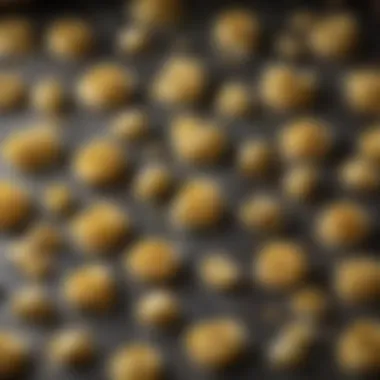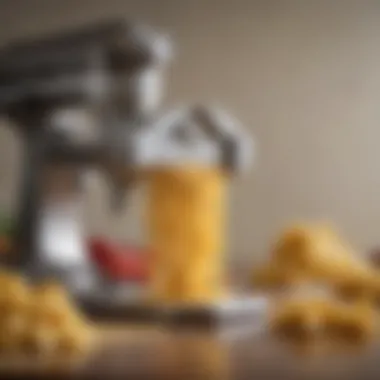Mastering Homemade Pasta with KitchenAid Attachments


Intro
The allure of authentic pasta is hard to resist. Imagine biting into a plate of perfectly crafted fettuccine or a robust ravioli filled with rich ingredients. Quality tools matter in the kitchen, especially when embarking on the culinary journey of creating fresh pasta at home. Among these tools, the KitchenAid pasta roller and cutter attachment stands out as a key player. This attachment combines functionality and ease of use, aiming to elevate home cooking into a delightful experience.
In this section, we will unravel the features and benefits of this kitchen gadget, highlighting why it deserves a spot in your culinary arsenal. Let’s dive into the heart of pasta-making and discover how this attachment can simplify your tasks while ensuring delicious results.
The KitchenAid pasta roller and cutter attachment transforms the ordinary task of pasta-making into an efficient, enjoyable process. Instead of rolling out dough by hand, which can be labor-intensive, this attachment allows for consistent thickness and texture with just a few turns of the handle. This not only saves time but also minimizes effort.
"Quality tools are a chef's best friends; they turn potential failures into triumphs."
Home cooks and enthusiasts alike will find that understanding different types of pasta and utilizing the right tools can redefine their culinary creations. With the KitchenAid attachment, not only can one experiment with various pasta shapes and styles, but it also opens the door to creativity in flavor and filling options.
As we explore this attachment further, we'll discuss its functionality, maintenance, and techniques to maximize its use. We will also touch on its role in the grand tradition of Italian cuisine, making this guide not just a manual, but a gateway to exploring the rich history and culture behind pasta making.
Foreword to the KitchenAid Pasta Roller and Cutter Attachment
In the culinary world, few delights compare to the allure of fresh pasta. And when it comes to making this sumptuous staple, the KitchenAid Pasta Roller and Cutter Attachment generates a mix of awe and practicality in the heart of the kitchen. It is not merely an accessory; it’s a gateway to unleashing the gastronomic potential locked away in flour and eggs. Utilizing this tool can transition anyone from a home cook to an adept pasta creator, enabling the reproduction of traditional recipes with a touch of authenticity.
When considering the significance of this attachment, one must recognize a few compelling aspects. First, it makes the process of rolling and cutting dough convenient. Many may find the manual effort of hand rolling and cutting vexing, leading to unevenly shaped pasta that lacks the consistent texture found in store-bought varieties. With the KitchenAid attachment, you’re afforded an effortless method to achieve that even thickness and uniform curves which is crucial in Italian cooking.
Moreover, the attachment offers versatility in different pasta styles. From delicate fettuccine to wide lasagna sheets, this tool facilitates creativity in the kitchen. Home cooks can explore a range of textures and tastes by simply changing the settings and adapting techniques. Say goodbye to the one-size-fits-all forms from grocery stores, and embrace the chance to personalize your dishes.
Additionally, the ease of use opens up an exciting avenue for families to engage in cooking together. Children and adults can bond over making homemade pasta, leading to a deeper appreciation of the culinary arts. By crafting meals from scratch, families weave a tapestry of tradition that goes beyond simply eating; it’s about the experiences shared in the kitchen.
Finally, it’s worth noting that the KitchenAid attachment is engineered for durability. Constructed from high-quality materials, it withstands the rigors of regular use without compromising performance. Providing valuable assistance in the kitchen can be an investment that pays dividends in flavor and satisfaction.
In the following sections, we will unravel the many features and operational nuances of the KitchenAid Pasta Roller and Cutter Attachment, exploring what makes it a must-have for aspiring pasta enthusiasts.
"Homemade pasta is an experience—each piece carries the essence of its maker."
In essence, understanding the benefits of this attachment is crucial for anyone looking to delve into the art of pasta making. It sets the stage for a journey that celebrates culinary traditions and nurtures creativity.
Understanding the Attachment's Design and Components
When it comes to crafting homemade pasta, the design and components of the KitchenAid Pasta Roller and Cutter Attachment are not just accessories—they are the building blocks of an enriching culinary experience. Understanding these elements lays a solid foundation for every cook, whether you’re a novice in the kitchen or a seasoned chef looking to refine your pasta-making skills. A well-designed attachment means you can manipulate your dough with precision, yielding superior results in texture and flavor.
- Material Quality and Durability
The materials used in this attachment can make or break your pasta-making journey. You want components that stand the test of time, which is why KitchenAid opts for robust materials like stainless steel. Not only does stainless steel provide exceptional durability, but it also resists corrosion. This is essential for anyone who anticipates using the attachment frequently.Beyond just durability, high-quality materials enhance safety as well. You won’t have to worry about flaking or harmful substances leaching into your food. - Key Parts and Their Functions
Understanding the individual components of the attachment gives you insight into its versatility. At a glance, the attachment may seem simple, but it's wise to know what each piece contributes to the process of making your pasta.
- Benefits of Quality Materials:
- Resistance to wear and tear.
- Easy to clean and maintain.
- Retains heat, which is beneficial for consistent rolling and cutting.
- Roller Cylinder: This part is crucial for flattening the dough evenly. You’ll find that the roller allows you to set the thickness according to your preference, ensuring your lasagna sheets are just as unevenly wonderful or your fettuccine strips are perfectly uniform.
- Cutter Blades: The cutter blades are your ticket to various pasta shapes. Depending on the type of blade you use, you can create anything from delicate tagliatelle to robust pappardelle. It's this adaptability that aids you in customizing your dishes to suit seasonality and availability of ingredients.
Ultimately, understanding the design and components lets you optimize the use of your KitchenAid Pasta Roller and Cutter Attachment. By grasping how each part works, you'll not only gain confidence in your cooking but also ensure that you are getting the best flavor and texture from your homemade pasta.
How the Pasta Roller Works
In the realm of homemade pasta, the KitchenAid pasta roller is a trusty aide that opens doors to a culinary experience like no other. Understanding how this attachment operates is essential for anyone aiming to create perfectly rolled sheets of pasta. The way it works not only enhances the quality of the pasta but also simplifies a traditionally labor-intensive process. Using a pasta roller can transform an often overwhelming task into an accessible and enjoyable part of cooking.
Setup and Installation Process
The first step to harnessing the potential of the KitchenAid pasta roller involves setting it up correctly. This isn't a task that should be underestimated; rather, it's the foundation of your pasta-making journey. To start, ensure your KitchenAid stand mixer is unplugged and positioned securely on your countertop. Attach the pasta roller by following these essential steps:
- Prepare the Mixer: Make sure your KitchenAid is on a flat surface, and have the power cord clear from any clutter.
- Attach the Roller: Locate the attachment hub at the front of the mixer. Align the pasta roller's base to the hub, slide it in, and rotate it until you feel it lock in place. A slight click signifies that it’s secure.
- Adjust the Settings: Most rollers come with settings to modify the thickness of your pasta. Decide on the thickness you prefer for your dough, ranging from thick for lasagna to thinner for fettuccine.


This approach not only ensures proper functionality but also guarantees that your pasta is uniform, essential for even cooking. Don't rush through this setup; a bit of care here will pay dividends later.
Rolling Techniques for Uniformity
Achieving uniform pasta sheets takes a bit of finesse, but it's definitely worth the effort. Here are some techniques to help ensure your pasta comes out consistently:
- Prepare Your Dough: Begin with well-kneaded and rested dough. If your dough is too sticky, it won’t roll out evenly. Dust the dough lightly with flour, but be careful not to overdo it.
- Start Thick: Always begin rolling at the thickest setting. Feed a portion of the dough through the roller, ensuring it enters evenly. If it gets stuck, you might need to adjust the settings or add a touch more flour.
- Gradual Reduction: Once your dough is passed through at the thickest setting, gradually move to thinner settings. This slow adjustment helps to maintain the structure and integrity of the dough.
- Keep an Eye on Textures: Aim for a smooth, consistent sheet with no tears or holes. If you find holes, it may be worth rolling back through once or twice before advancing.
"The key to rolling perfect pasta lies in patience and technique—don’t rush the process!"
By adopting these methods, you can create pasta that not only looks beautiful but also cooks evenly, enhancing both the dining experience and the delight of homemade meals.
Understanding Different Pasta Styles
Recognizing various pasta styles is fundamental to fully appreciating the art of Italian cooking. Each type of pasta has its own persona, bringing a unique texture and taste to dishes. The KitchenAid pasta roller and cutter attachment makes it easy to craft these varieties right at home. Understanding the distinctions between pasta shapes not only enhances your culinary repertoire but also allows you to make the most of your attachment by tailoring your dishes to specific types of sauce or preparation methods.
Moreover, mastering different pasta styles can elevate your cooking to a level that impresses your family and friends. It’s not just about following a recipe; it's about engaging with the heritage of pasta-making and connecting with the Italian culture that celebrates this staple ingredient. In a nutshell, knowing the different kinds of pasta gives you the power to make informed choices in the kitchen.
Common Types of Pasta You Can Make
When you’re using the KitchenAid pasta roller and cutter attachment, the world of pasta opens up before you. Here are some popular types you can effortlessly create:
- Fettuccine: This flat noodle is ribbon-like and pairs beautifully with creamy sauces like Alfredo. Perfect for those hearty dishes that just call for comfort.
- Pappardelle: Wider than fettuccine and traditionally served with rich meat sauces. The larger surface area allows it to hold onto flavors exceptionally well.
- Lasagna Sheets: With the roller attachment, you can create your own fresh pasta sheets, ensuring your lasagna is layered with nothing but homemade goodness.
- Tagliatelle: Similar to fettuccine but typically slightly thinner, it's popular in the Emilia-Romagna region and works wonderfully with ragu.
- Spaghetti: While it may require a different cutter, you can enjoy making fresh spaghetti that brings a burst of flavor and chewy texture, incomparable to dried versions.
Each type has its attributes, and mastering them allows you to personalize your pasta dishes, ensuring you cater to various tastes and preferences.
Regional Variations in Pasta Recipes
Exploring regional variations in pasta recipes can be a delightful journey through Italy's diverse culinary landscape. Pasta is not just a dish; it reflects local traditions, ingredients, and cooking techniques. Consider these delights:
- Bolognese from Bologna: Known for its rich meat sauce, fresh tagliatelle is the choice of pasta, absorbing the sauce’s depth perfectly.
- Pesto from Genoa: Liguria’s famous basil-based sauce pairs well with trofie or trenette, two traditional shapes that catch the intense flavors effortlessly.
- Cacio e Pepe from Rome: This simple yet decadent dish highlights spaghetti or tonnarelli, elevating just cheese and pepper to a sophisticated level.
- Seafood Pasta from Southern Italy: Varieties like linguine combine beautifully with fresh seafood, embodying the Mediterranean lifestyle.
When using your KitchenAid attachment, consider how these regional insights can inspire you to craft authentic dishes, connecting with the aroma and taste of Italy in each bite.
"Exploring pasta isn't just about eating; it's about experiencing different cultures on your plate."
By making different styles and exploring regional variations, you not only broaden your kitchen skills but also deepen your culinary appreciation. This attachment isn't only a tool; it's a gateway to a rich and flavorful culinary journey.
Using the Cutter Attachment
The KitchenAid pasta roller and cutter attachment plays a pivotal role in transforming your homemade dough into a feast of pasta varieties. With this attachment, creating restaurant-quality pasta right in your kitchen becomes not only feasible but also thrilling. The cutter attachment allows for a range of pasta styles, catering to various tastes and culinary explorations. The significance of this component lies not only in its versatility but also its ability to elevate your cooking experiences.
Changing the Attachments for Different Cuts
Switching between attachments to achieve various pasta cuts is a streamlined process that enhances the overall efficiency of your cooking. KitchenAid has designed this attachment to make it intuitive, allowing both novices and seasoned cooks to transition from one type of cut to another effortlessly. For instance, if you’re looking to create fettuccine, simply attach the fettuccine cutter and you’re ready to roll. Want to try your hand at lasagna? Quickly swap it out for the lasagna cutter.
Here are some key elements to consider when changing attachments:
- Alignment: Ensuring that the attachment fits securely is crucial for safe operation.
- Dough Thickness: Thinner dough works best for delicate cuts like angel hair, while thicker sheets might be suitable for lasagna.
- Cleaning Between Cuts: To achieve clean cuts and prevent flavors from overlapping, a quick clean of the attachment is sometimes necessary.
Techniques for Precision Cutting
Precision is key when it comes to pasta cutting. Utilizing the cutter attachment with finesse can yield stunning results. Not only does this promote uniformity, but it also affects how the sauce clings to your pasta. Here are some techniques that can help you nail that precision:
- Steady Hand and Eye Coordination: As the pasta sheets move through the cutter, a steady hand ensures uniformity. This is more about practice, and as you hone this skill, you'll notice a significant improvement in your output.
- Utilize Pasta Drying Racks: After cutting, laying the pasta out on a rack prevents sticking and ensures you're ready to cook or store.
- Mind the Thickness: Adjust the roller to control the thickness of the pasta sheet before cutting. Remember, the thinner the sheet, the more delicate the noodle, so gauge appropriately according to the dish you plan to prepare.
"The beauty of cooking pasta lies in the precision. A slight adjustment here or there can lead you to the masterpiece you seek."


By adopting these techniques, you’ll not only enhance the aesthetic of your dishes but also ensure that each bite delivers a delightful texture and taste experience.
Culinary Benefits of Fresh Pasta
The allure of fresh pasta goes far beyond mere aesthetics; it embodies the heart and soul of Italian culinary tradition. Making pasta from scratch with the KitchenAid pasta roller and cutter attachment can revolutionize your cooking experience. It pivots around the profound connections between food and personal nutrition, tradition, and flavor. Choosing fresh over store-bought isn’t just a trend; it's a gateway to enhancing the very essence of your meals.
When you prepare pasta fresh at home, you tap into a treasure trove of benefits that elevate your dining experience. This section probes into two primary enhancements that freshly made pasta provides: taste and texture, and nutritional advantages compared to its mass-produced counterparts.
Taste and Texture Enhancement
Fresh pasta has a unique charm that no factory-made equivalent can duplicate. First and foremost, it offers an unmatched texture. When you roll it out using the KitchenAid attachment, you have control over the thinness and pliability of the dough, leading to a perfectly chewy bite. This can make a world of difference in absorbing sauces and flavors.
Additionally, the flavor is indeed more pronounced. Fresh pasta allows the natural ingredients to shine through. You can use high-quality flours, perhaps even semolina. You can tailor the flavors, too, incorporating various ingredients—maybe some spinach or beet juice for color and taste. All of this contributes to a more delightful culinary experience.
Cooking fresh pasta is a swift endeavor, taking only a few minutes in boiling water. It tends to retain more of the wheat's natural flavor, providing a nuanced backdrop for your sauces to dance on. The richness of homemade pasta can make even the simplest dish feel exquisite, transforming a weeknight dinner into something special.
"The secret of great cuisine is simplicity. Fresh pasta exemplifies this principle beautifully."
Nutritional Advantages Over Store-Bought
Turning our gaze to nutrition, it’s hard to overlook the stark differences between fresh and store-bought pasta. Many commercial brands utilize preservatives, artificial colors, and assorted additives to extend shelf life. In contrast, creating your pasta gives you complete control over what goes in and, equally important, what stays out.
Key nutritional benefits of fresh pasta include:
- Quality Ingredients: You can choose organic or locally sourced flour, ensuring the best possible quality and nutrition.
- Minimal Additives: Homemade pasta usually consists of just flour, water, and eggs. This simplicity leads to fewer allergens and unwanted chemicals.
- Tailored Nutrition: You can easily adjust recipes to infuse more nutrients. For instance, adding whole wheat flour or incorporating vegetable purees boosts fiber content significantly.
Fresh pasta also allows for more creativity in the kitchen. You can craft pastas that cater to various dietary needs without compromising flavor or texture. Whether gluten-free, vegan, or enriched with high-protein flour, the possibilities are endless.
From texture enhancements that affect how a meal feels in your mouth to nutritional benefits that better support your body, fresh pasta is truly an invaluable asset in any home cook's repertoire. Elevating your culinary skills while fostering a healthier lifestyle is a twofold reward of using the KitchenAid pasta roller and cutter attachment.
Maintenance and Care for Your Attachment
Proper maintenance and care of the KitchenAid pasta roller and cutter attachment are essential for ensuring its longevity and consistent performance in the kitchen. Just like a well-cared-for instrument can yield beautiful music, a well-maintained attachment can result in splendid pasta dishes every time you use it. By preserving the integrity of your equipment, you not only enhance the quality of your cooking but also reduce the risk of malfunctions or premature wear and tear. Ultimately, a little effort in maintenance can save you time and money down the line.
Cleaning Procedures After Use
Cleaning the attachment might seem like a chore, but it's a crucial step that shouldn’t be overlooked. After all, no one wants leftover flour or dough fragments playing hide-and-seek in their kitchen equipment. Begin by unplugging your KitchenAid mixer to ensure safety during the cleaning process. Once done, follow these steps:
- Disassemble the Parts: Gently detach the roller and cutter components. Be careful while handling these parts to avoid any damage.
- Brush Off Excess Flour: Use a soft brush or a small pastry brush to remove flour and dough remnants. This step is important because leftover particles can harden and affect future usage.
- Wipe with a Damp Cloth: Dampen a cloth with warm water and wipe down the surfaces. Avoid submerging the attachments in water as it can harm the internal gears.
- Air Dry: Place the cleaned parts on a drying rack to air dry completely before reassembling. This helps prevent moisture from causing rust or corrosion.
Adhering to these cleaning procedures doesn’t just maintain hygiene; it ensures optimal performance every time you decide to roll or cut pasta.
Storage Recommendations for Longevity
Storing the KitchenAid pasta roller and cutter attachment properly can significantly extend its lifespan. Just like how a fine wine is best stored in a cool dark place, your kitchen tool deserves thoughtful placement too. Here are a few storage tips that might help:
- Choose a Dry and Cool Location: Keep the attachment in a kitchen cabinet or drawer, away from heat sources or direct sunlight.
- Use Protective Covers: Consider using soft cloth bags or protective covers to wrap the attachment. This shields it from dust and potential scratches.
- Organize for Easy Access: Position it near your mixer or in a spot where you frequently cook. Accessibility encourages regular use, making fresh pasta a delightful routine rather than a laborious task.
By keeping these storage considerations in mind, you can harness the full potential of your KitchenAid pasta roller and cutter attachment, allowing it to remain a trusty companion in your pasta-making adventures for years to come.
"Proper care is as crucial as the ingredients you choose; it ensures that your culinary tools help you create masterpieces in the kitchen."
By following these maintenance and care tips, you’ll ensure that your KitchenAid pasta roller and cutter attachment remains a well-oiled machine, ready for action whenever you feel inspired to create homemade pasta.
Incorporating the Attachment into Regular Cooking Routines


Using the KitchenAid pasta roller and cutter attachment is not just about making a batch of pasta now and then; it’s about fostering a culinary practice that elevates everyday meals into something special. Integrating this attachment into your cooking routine turns the kitchen into a place of creativity and joy. It brings the warmth of traditional Italian cooking right into your home, allowing you to experiment with flavors and textures while making cooking a delightful experience.
Creating Unique Dishes at Home
When equipped with the KitchenAid pasta roller and cutter, the possibilities for unique dishes are practically limitless. With each creation, you can put a personal twist on age-old recipes. For instance, have you ever tried sweet potato gnocchi? Using the attachment, the process becomes simpler, allowing you to focus on the flavors rather than just the laborious task of mixing and kneading dough. By perhaps switching up the dough with different flours or incorporating herbs and spices, you introduce a new dynamic to conventional pasta.
- Experiment with Ingredients: Try making your own ravioli stuffed with everything from traditional meats and cheeses to innovative combinations like spinach and ricotta or even butternut squash with sage.
- Try International Varieties: The roller isn't just for Italian favorites. Get adventurous with Asian dumplings or even Eastern European pierogi, broadening your palate right in your kitchen.
Ultimately, it's about personal expression through food. The joy of serving a dish you crafted yourself adds a level of satisfaction. Every time you roll out fresh pasta, you’re not just cooking; you’re telling a story of creativity and love for food.
Making Pasta Part of Family Traditions
Incorporating the pasta roller into your family cooking rituals can transform a simple meal into a cherished tradition. Think about it: gathering family members around the kitchen counter, hands flour-dusted and laughter filling the air as everyone contributes to the pasta-making process.
This practice fosters not only bonding but also a sense of history that can be passed down through generations.
- Make it a Weekly Tradition: Set aside Sundays for pasta-making and create a variety that the family can enjoy throughout the week. Whether it’s tagliatelle, lasagna, or traditional tortellini, let each family member pick their favorite type.
- Teach the Next Generation: Use this time to instruct younger family members about dough, shapes, and flavors, and share stories of family meals past. You’re not just creating pasta; you’re building lasting memories.
"Cooking is a connection to the past. When we make pasta at home, we're carrying on traditions that link generations."
In the hustle and bustle of daily life, taking the time to make pasta together enhances your meals and turns them into celebrations. It solidifies family bonds through shared experiences, while creating delicious dishes that linger in both taste and memory.
Frequently Asked Questions
In any kitchen, questions abound, and when it comes to the KitchenAid Pasta Roller and Cutter Attachment, there are plenty of inquiries that pop up. Understanding these frequent queries can greatly enhance your pasta-making journey. First off, the questions often arise from a desire to ensure compatibility, efficiency, and optimal performance of this attachment.
This section specifically aims to address some of these core concerns. By doing so, you not only gain clarity on how to utilize this machinery to its fullest but also save time and avoid unnecessary frustrations that can occur during the cooking process.
Compatibility with Other KitchenAid Attachments
One of the most common questions relates to compatibility. Many users wonder whether their pasta roller and cutter attachment can seamlessly integrate with other KitchenAid attachments they may have. The good news is that the majority of attachments are designed to work harmoniously with the KitchenAid stand mixer.
To ensure that you’re making the most of your kitchen's capabilities, here are some key points:
- Universal Fit: Most KitchenAid attachments, including the pasta roller, share the same drive system. This design means that many attachments will fit onto the mixer without issues, as they are tailored to work together.
- Specific Combinations: If you have a food grinder or fruit and vegetable strainer, pairing these with your pasta roller can open doors to unique culinary creations, like adding flavored pasta or fresh sauces.
- Check Compatibility: Always ensure that your specific model of KitchenAid stand mixer supports the attachment. While older models may have limitations, newer ones typically accommodate a wider range of attachments.
Troubleshooting Common Issues
Even the best equipment can sometimes run into hurdles. ? Amidst the joys of making fresh pasta, occasional hiccups can occur. Knowing how to troubleshoot enables smoother operations and saves you from potential pasta-making disasters.
Here’s how you can navigate through common issues:
- Pasta Sticking: If your sheets are sticking, make sure you are using enough flour. Too little can lead to frustrating complications.
- Uneven Thickness: If the pasta isn’t rolling out to a uniform thickness, check the settings. Using a consistent feed rate and avoiding cramming large amounts of dough at once will help.
"Consistency is key; remember to maintain even pressure and movement when rolling."
- Clogging: Sometimes, small pieces of dough can clog the cutter. Regularly clean the cutting attachments using a stiff brush or a clean cloth to avoid this issue.
By addressing these frequently asked questions and their solutions, you can ensure that your experience with the KitchenAid Pasta Roller and Cutter Attachment is nothing short of stellar. Understanding your tools will lead to both quality pasta and a more enjoyable cooking process.
The End: The Value of Homemade Pasta
Homemade pasta is more than just a dish; it’s a connection to culinary tradition and a testament to dedication in the kitchen. The KitchenAid pasta roller and cutter attachment brings this experience into your home, allowing you to craft pasta with the kind of care that pre-packaged options simply cannot match.
One of the significant advantages of making pasta from scratch is the control you gain over ingredients. By selecting high-quality flour and fresh eggs, you’re not only enhancing flavor but also ensuring a fresher product devoid of artificial preservatives. This consideration becomes increasingly relevant in today's health-conscious society, where consumers are more aware of what they put into their bodies.
"Homemade pasta elevates any meal, transforming simple ingredients into a feast of flavors and textures."
Another defining factor in the homemade pasta experience is the sense of pride in your culinary creations. There’s a certain satisfaction derived from rolling out dough into thin sheets and seeing the transformation from flour and eggs into beautiful, delicate noodles. Each batch offers a unique opportunity to refine your techniques and develop your personal touch, whether it’s lasagna sheets or fettuccine strands. The process becomes an engaging activity that could easily draw friends or family into your kitchen, fostering memorable moments together.
On the flip side, understanding the nuances of different pasta types is crucial. With the ability to create various shapes and styles using the KitchenAid attachment, you can explore cuisines beyond the typical. The challenge of replicating dishes like pappardelle or tagliatelle, for instance, can expand your culinary horizons. Embracing these diverse recipes not only enriches your skill set but also brings more variety to your dining table.
Lastly, let’s not overlook the impact of homemade pasta on sustainability. When you prepare pasta at home, you reduce packaging waste associated with store-bought varieties. Additionally, you can often source ingredients locally or select organic options, aligning with more environmentally friendly practices.
In sum, the KitchenAid pasta roller and cutter attachment doesn't just make pasta; it opens the door to authentic culinary experiences that honor tradition while allowing creativity to flourish. The value found in homemade pasta spans flavor, nutrition, engagement, and sustainability, making it an endeavor well worth pursuing in any home kitchen.







